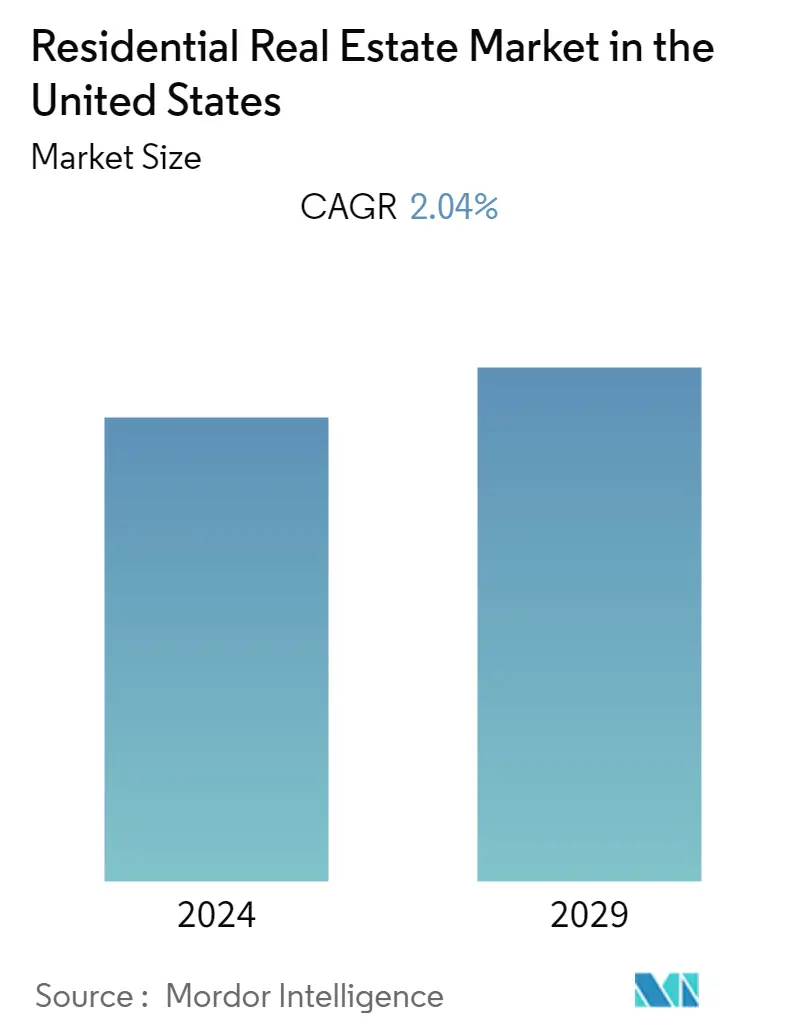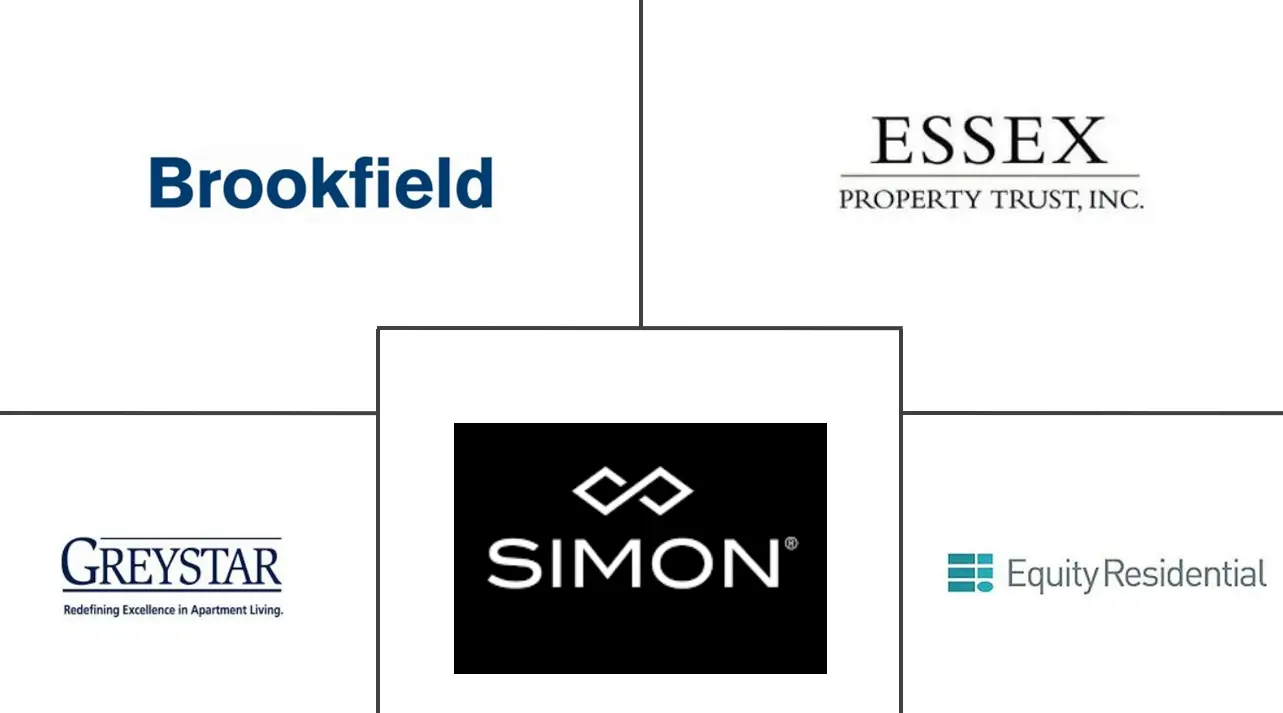Market Size of Residential Real Estate Industry in the United States

| Study Period | 2020 - 2029 |
| Base Year For Estimation | 2023 |
| Forecast Data Period | 2024 - 2029 |
| Historical Data Period | 2020 - 2022 |
| CAGR | 2.04 % |
| Market Concentration | Low |
Major Players
*Disclaimer: Major Players sorted in no particular order |
US Residential Real Estate Market Analysis
The Residential Real Estate Market in the United States is estimated at USD 2.53 trillion in 2023, and is expected to reach USD 2.80 trillion by 2028, growing at a CAGR of 2.04% during the forecast period (2023-2028).
- Furthermore, the COVID-19 impact was severe on the market. Despite the pandemic crisis, residential real estate in the country is in the recovery phase, as the sales in the country quickly bounced back to pre-pandemic levels.
- Since the start of the COVID-19 pandemic, the property market in the United States has been thriving. Many purchasers took advantage of the low-interest rates to restructure their mortgages, relocate, or take a step toward the American Dream by purchasing their first home. Owing to this, the number of home sales increased sharply in the second half of 2020 and has since stayed higher than before the pandemic. Prior to the pandemic, home prices had been on the rise, but with demand at an all-time high in 2020, the Freddie Mac House Price Index recorded a startling 11.3% increase.
- At the beginning of 2021, about 60% of properties were sold above their advertised prices as a result of the "race for space" among homebuyers. Although the market has begun to moderate, the lack of available inventory and rising construction costs are anticipated to keep pushing up the price of homes.
- The price of single-family homes increased by more than 20% in numerous states of the United States. As of the end of 2021, some of the states with the highest property appreciation rates were Arizona, Utah, Idaho, Florida, and Tennessee.
- Furthermore, the mean value of a single-family home was significantly higher than the average sales price of both new homes and existing homes in states like California, Washington, and Massachusetts.
- The housing market in the Golden State is among the most competitive when compared to other metropolitan areas. A home in San Jose, Sunnyvale, Santa Clara, or San Francisco would cost purchasers more than USD 1,000,000.
- The demand for multifamily houses increased when compared to single-family homes. Housing starts in single-family homes were at 1.11 million units based on the seasonally adjusted annual rate (SAAR) in the second quarter of 2021, and multifamily housing starts were at 467,000 units (SAAR), which is 9% greater than the previous quarter in 2021, and 55% higher than the same quarter in the previous year (2020).
- Furthermore, the inventory of homes on the market increased for both new and existing homes. The listed inventory of new homes for sale at the end of the second quarter was 348,000 units based on seasonal adjustments (SA), at a growth rate of more than 14% from Q1 2021. Additinally, it registered a growth of 16% compared to the previous year.
US Residential Real Estate Industry Segmentation
Residential real estate refers to properties that are exclusively designed for human occupation. Furthermore, the report provides key insights into the residential real estate market in the United States. It includes technological developments, trends, and initiatives taken by the government in this sector. It also focuses on market dynamics. Additionally, the competitive landscape of the residential real estate market in the United States is depicted through the profiles of key active players.
The Residential Real Estate Market in the United States is Segmented by Property Type (Apartments and Condominiums, Landed Houses and Villas). The report offers market size and forecasts for the residential real estate market in the United States in value (USD Trillion) for all the above segments.
| By Property Type | |
| Apartments and Condominiums | |
| Landed Houses and Villas |
Residential Real Estate Market in the United States Size Summary
The residential real estate market in the United States is experiencing a phase of recovery and growth following the disruptions caused by the COVID-19 pandemic. The market, which was significantly impacted by the pandemic, has rebounded as sales quickly returned to pre-pandemic levels. The demand for homes surged as buyers capitalized on low-interest rates, leading to a notable increase in home sales and prices. The "race for space" phenomenon drove many properties to sell above their listed prices, although the market has begun to moderate. Despite this moderation, factors such as limited inventory and rising construction costs are expected to continue driving home prices upward. The market is characterized by a strong demand for multifamily homes, with significant increases in both single-family and multifamily housing starts.
The residential real estate sector is fragmented, with a few large companies holding a substantial portion of the market share, while smaller firms compete by leveraging local market expertise. The market dynamics are influenced by regional variations in sales, with the southern region leading in transactions. The sector has seen a rise in homeownership, particularly among middle-aged and older citizens, and a growing interest from first-time buyers and investors. The market's resilience is evident in the increasing availability of housing units and the ongoing demand for apartments and condominiums. However, inflationary pressures have posed challenges, affecting consumer spending and impacting the homeownership sector. Major players in the market, such as Blackstone and Equity Residential, continue to expand their portfolios, indicating a robust outlook for the residential real estate market in the coming years.
Residential Real Estate Market in the United States Market Size - Table of Contents
-
1. MARKET INSIGHTS AND DYNAMICS
-
1.1 Market Overview
-
1.2 Market Dynamics
-
1.2.1 Market Drivers
-
1.2.2 Market Restraints
-
1.2.3 Market Opportunities
-
-
1.3 Insights into Technological Innovation in the Residential Real Estate Sector
-
1.4 Government Regulations and Initiatives
-
1.5 Supply Chain/Value Chain Analysis
-
1.6 Industry Attractiveness - Porter's Five Forces Analysis
-
1.6.1 Threat of New Entrants
-
1.6.2 Bargaining Power of Buyers/Consumers
-
1.6.3 Bargaining Power of Suppliers
-
1.6.4 Threat of Substitute Products
-
1.6.5 Intensity of Competitive Rivalry
-
-
1.7 Impact of COVID-19 on the Market
-
-
2. MARKET SEGMENTATION
-
2.1 By Property Type
-
2.1.1 Apartments and Condominiums
-
2.1.2 Landed Houses and Villas
-
-
Residential Real Estate Market in the United States Market Size FAQs
What is the current United States Residential Real Estate Market size?
The United States Residential Real Estate Market is projected to register a CAGR of 2.04% during the forecast period (2024-2029)
Who are the key players in United States Residential Real Estate Market?
Essex Property Trust, Greystar Real Estate Partners, Equity Residential, Simon Property Group and Brookfield Asset Management Inc. are the major companies operating in the United States Residential Real Estate Market.
Residential Real Estate Market in the United States Report Snapshots
- Residential Real Estate Market in the United States Market Size
- Residential Real Estate Market in the United States Market Share
- Residential Real Estate Market in the United States Market Trends
- Residential Real Estate Market in the United States Companies
- Residential Real Estate Market in the United States News

